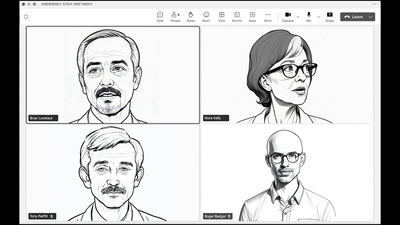BROWN, Ian (2025) Emergency Staff Meeting. [Artefact]
![[thumbnail of Emergency Staff Meeting Ian Brown.jpg]](https://eprints.staffs.ac.uk/9333/1.hassmallThumbnailVersion/Emergency%20Staff%20Meeting%20Ian%20Brown.jpg)

Emergency Staff Meeting Ian Brown.jpg - Cover Image
Available under License Type All Rights Reserved.
Download (404kB) | Preview
Abstract or description
The research focuses on how institutions and their employees navigate the continual state of flux incurred by operating in contemporary Britain’s Neo-liberal political landscape, and the pressures that this entails. This is grounded in the instability created as a consequence of the frequency of organisational changes (restructures and mergers) seemingly necessitated by the marketisation of the sector.
The project utilises forms of narrative storytelling, humour and satire within a contemporary art context.
One area of interest lies in the relationship between “the institution” and “the individual” and the synergies or tensions that lie between them. This recognises that the institution operates as a form of power and authority, a seemingly homogenous entity, as well as a place of belonging, but it is also experienced as both faceless and ‘other’, as having agency and autonomous in its actions.
The research both utilises autoethnography as method, and draws on debates surrounding the implications of its usage in artistic practices, specifically, the relation to the authors’ own employment within the very structure they critique (relational ethics).
The UK University system is being ruthlessly administered – to be more efficient, economical, marketable, transactional. It has adapted the strategies and languages of corporate business in order to be efficient and competitive in the marketplace.
The use of generative AI for us was seen as appropriate in the context of the mismatch between certain views of an art school and the commercial systems and agendas it now has to operate within. Furthermore, the notion of the University as an entity, in and of itself, is comparable to the anthromoprhisation of ai systems, providing both with a sense of independent agency.
The dataset, that is provided at the outset of the model training, is limited to the imagery available online, which is, in itself, a resource offered by dominant commercial cultural forces. Some examples generated had slightly garbled ‘iStock’ watermarks on them, for example. As Hito Steyerl argues, the ‘invitation’ for artists to use ai can be seen as a form of onboarding for commercial entities.
The dialogue recognises the reality of the precarious positions that post-92 institutions find themselves in, in a neo-liberal marketized education sector. The finances of institutions are tied to recruitment which in turn is tied to an ability to market the value/quality of the education provided.
| Item Type: | Artefact |
|---|---|
| Faculty: | School of Digital, Technologies and Arts > Art and Design |
| Event Location: | Iceland University of the Arts |
| Depositing User: | Ian BROWN |
| Date Deposited: | 07 Oct 2025 14:38 |
| Last Modified: | 07 Oct 2025 14:38 |
| Related URLs: | |
| URI: | https://eprints.staffs.ac.uk/id/eprint/9333 |

 Tools
Tools Tools
Tools